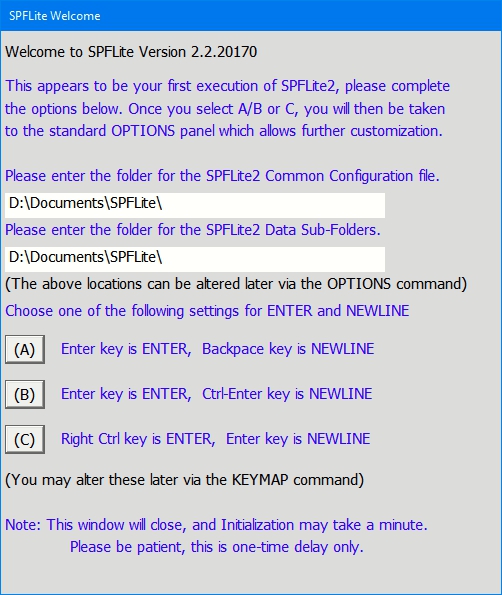Default Key Definitions
Contents of Article
SPFLite standard key mapping defaults
Standard F1 through F12 key mappings
Additional installation-supplied key mappings
Introduction
As described under "Keyboard Customization" you can map the physical keyboard keys to any logical Primitive functions you desire.
During the first execution of SPFLite following install, you are presented with a popup display and asked to choose between three different key assignments for the ENTER and NEWLINE keys. You must choose one of the options. If none suit your preference, you must still choose one to start with; you can immediately change these settings with the KEYMAP primary command. The initial assignment here is done to prevent SPFLite from setting defaults that you are not aware of. Since the particular choice you make is important, you may wish to make a note of it somewhere.
The popup display looks like this:

Your choice above will then be included with the standard key defaults.
SPFLite standard key mapping defaults
SPFLite is installed with a standard set of predefined keys to get you started. Many users choose to immediately alter some of these to their own preferences. The predefined defaults reflect common usage in mainframe ISPF, PC-based ISPF emulators and text-mode Windows editors. Most users will find these defaults a useful place to begin.
Why doesn't SPFLite just map every possible function to a standard set of keys for you, instead of requiring you to make mapping choices for all these functions? First, you may not need or be interested in using every last function, but just the ones that are important to your work. Second, you may have experience with other editors, and you probably would rather have your keys do what you want them to, instead of having SPFLite make those choices.
As well, your physical keyboard may dictate some choices. a full 104 key keyboard has many more keys available over a laptop keyboard. What works well on a laptop would simply be ignoring the 17 keys available in the keypad of the 104 key keyboard, not taking advantage of those keys would be a real shame.
Throughout this Help, you will find suggested mappings for various commands and functions, which have been found to be useful. You are free to use these suggested mappings, or pick your own.
The following defaults are installed
- All alphabetic and numeric keys operate as normal.
- Insert / Delete / Home / Tab and Backtab (Shift-Tab), and Backspace operate as normal
- Page Up / Page Down keys by are mapped to generate the UP and DOWN commands.
Note: All these can of course be altered to whatever you wish using the KEYMAP facility.
Standard F1 through F12 key mappings
- F1 HELP
- F2 RESET
- F3 END
- F4 Unassigned
- F5 RFIND
- F6 RCHANGE
- F7 UP
- F8 DOWN
- F9 SWAP
- F10 LEFT
- F11 RIGHT
- F12 CRETRIEV
- S-F12 RETF
- KP-1 END
- KP-2 Down Arrow
- KP-3 PageDn
- KP-4 Left Arrow
- KP-5 Null
- KP-6 Right Arrow
- KP-7 HOME
- KP-8 Up Arrow
- KP-9 PageUp
- KP-0 INSERT
- KP-. (Period) DELETE
- KP-Enter ENTER
Additional installation-supplied key mappings
- ESC Erase to End-of-line
- PAUSE PA2 (Cancel this screen input)
- Right-Alt KEYMAP
- PrtScr Print screen to Clipboard
- S-PrtScr Print screen to printer
- C-PrtScr Print text portion of screen only to Clipboard
- A-PrtScr Print screen to SPFLite log file
- ScrlLock Toggle keyboard recording mode
- C-X Cut selected text to the Clipboard
- C-C Copy selected text to Clipboard
- C-V Paste text at cursor location; this will also perform block-paste operations
- End Cursor to end of line
- S-End Mark text to end of line
- S-Arrows Mark text in arrow direction
- C-Left Move cursor left one word
- C-Right Move cursor right one word